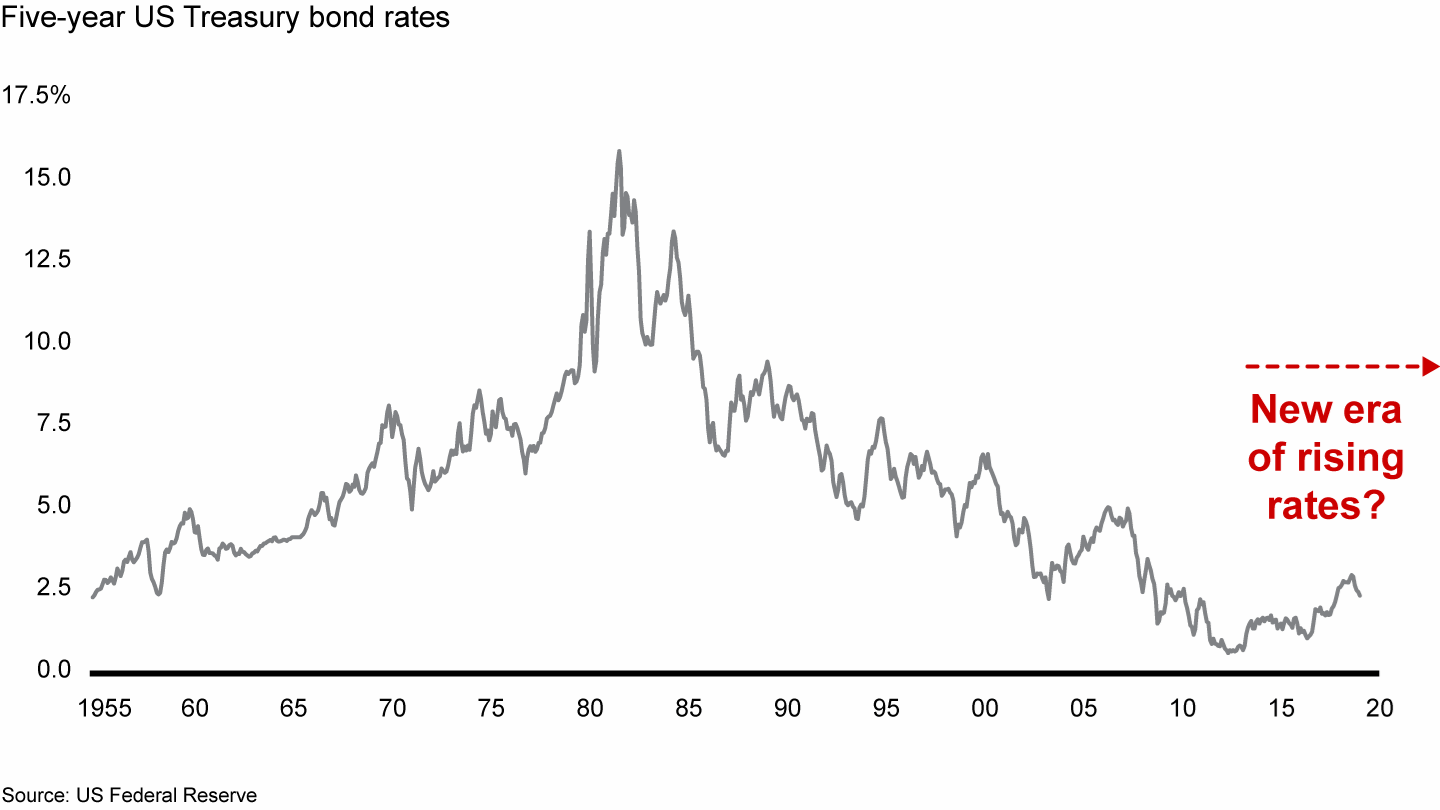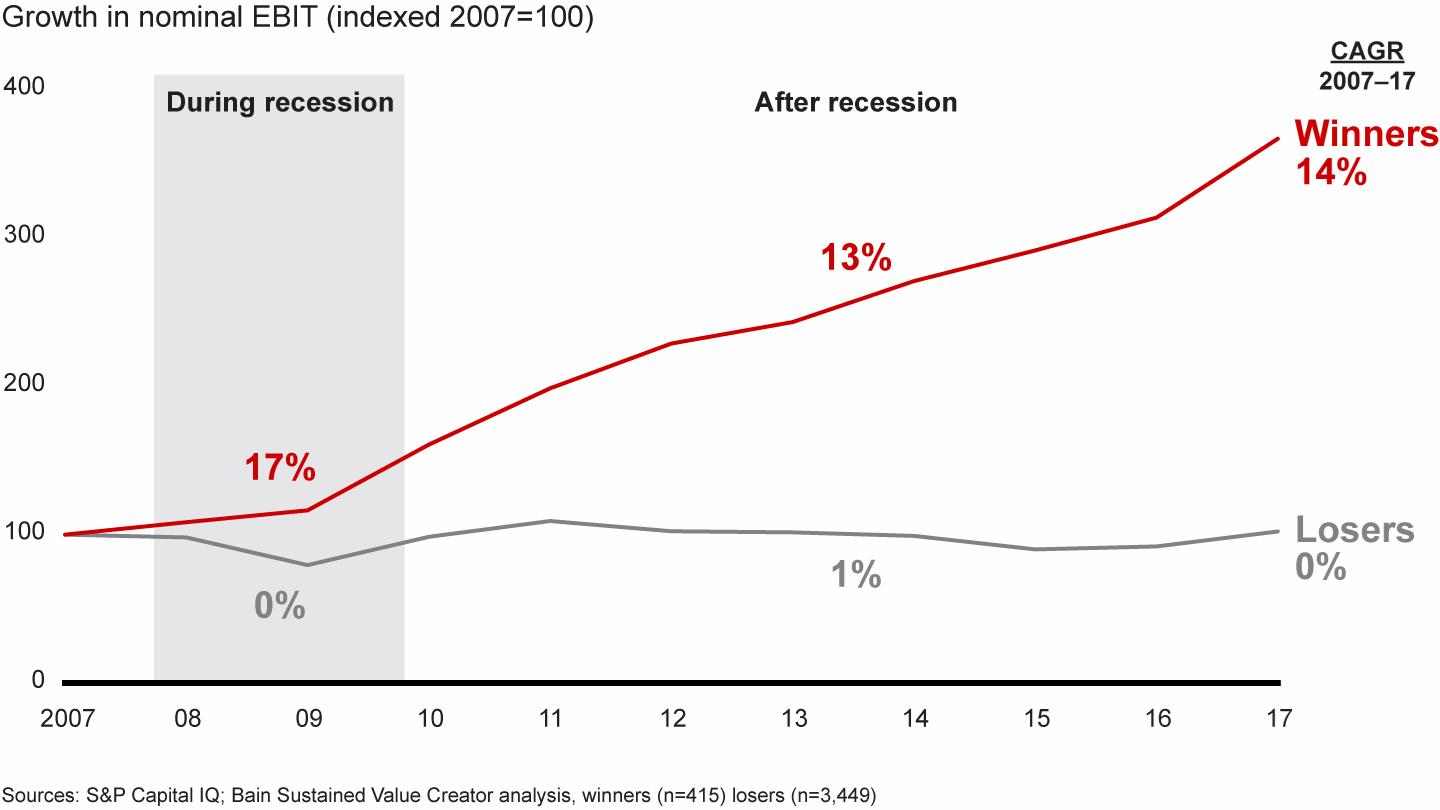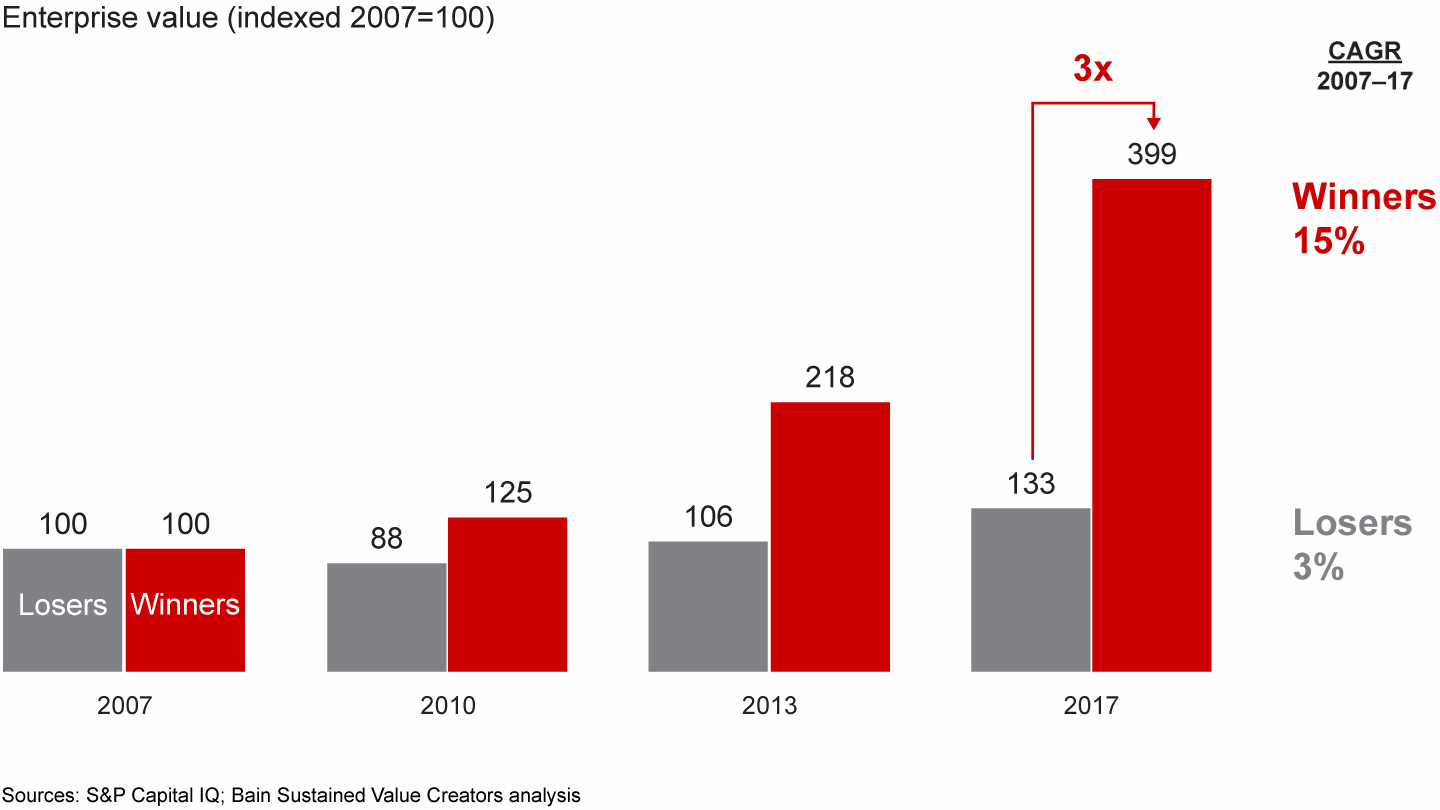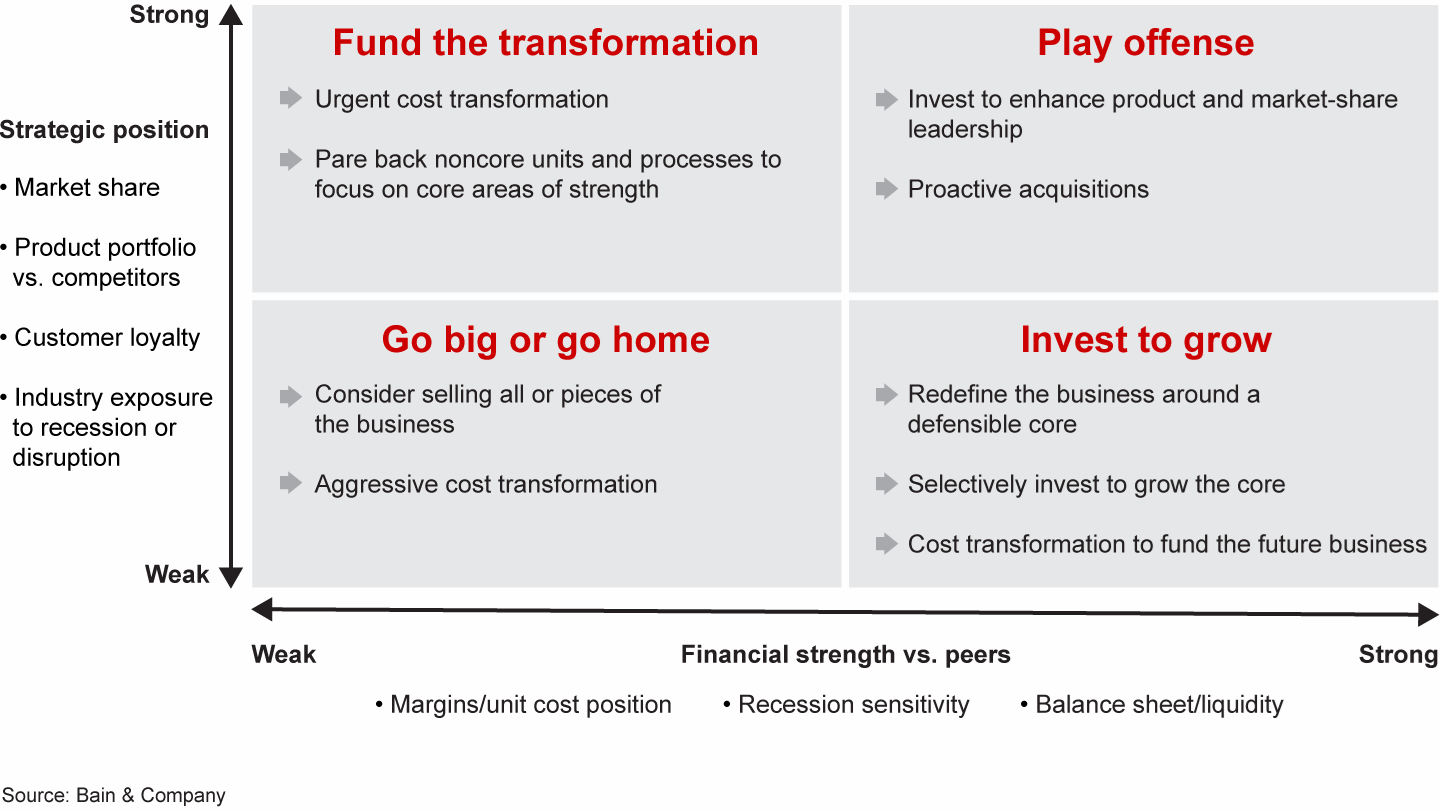Brief

Executive Summary
- A recession will likely land soon, and structural trends will influence a new cycle, notably the accelerating technology revolution in many industries and the end of decades of low interest rates.
- Preparing now enables companies to gain market share and accelerate: Winners pulled away from losers during the last recession and widened the profit and market-cap gap during the subsequent expansion, Bain’s analysis of nearly 3,900 companies worldwide shows.
- The winners excelled in four areas: early cost restructuring, financial discipline, aggressive commercial plays and proactive M&A.
- A four-point recession-readiness plan based on a company’s strategic and financial strength can help leadership teams prepare now.
It’s overdue. Predicting the onset of a recession is difficult, but a downturn likely will arrive soon, with the current economic expansion now more than 10 years old, long by historical standards. Signs of overleverage in the corporate sector, combined with geopolitical uncertainty—including the China–US trade war, Brexit and economic instability in some European countries—suggest the next recession is not far off.
For corporate leaders, however, the exact timing and duration of a recession matters less than being ready to seize the moment early, when they have more options. Getting ahead of the curve avoids the painful alternative—being forced to react hastily in a crisis. Bain & Company research shows that well-prepared companies emerged as winners during and after past recessions. They managed a strong defense and offense in parallel, reining in costs while simultaneously reinvesting in growth.

Recession Strategies
Several macroeconomic trends suggest the next recession may not be far off. These insights examine the moves that organizations can make now to prepare for a downturn and even thrive when it arrives.
The next downturn will figure as just one element roiling the global economy. Several structural changes will combine to sound the starting gun to a new business cycle, including:
- The end of nontech business. An array of evolving technologies will substantially alter customer behavior and demand in many sectors, disrupting both volume and price. In the automotive industry, shared mobility services and the shift to autonomous and electric vehicles could gut the economic returns of many manufacturing plants and assets in six to eight years—just one product cycle. In retail, digital-first insurgent brands with healthy balance sheets may take even more market share in a downturn, compounding the damage to many traditional retailers.
At the same time, new technologies are ramping up efficiencies in areas such as supply chain and manufacturing. Automation technologies, in particular, will accelerate to help companies address the dwindling supply of labor as more baby boomers move into retirement and labor force growth slows.
- The end of low interest rates. Interest rates still hover near a six-decade low (see Figure 1). Even if central bankers hold rates low during a downturn to help stimulate their economies, we expect to see rates eventually rise. This potential change in the interest rate environment will be a new regime for most management teams, and should prompt them to take a multiyear view of their capital structure and the timing of investments. A higher cost of capital will put pressure on capital spending, so if companies want to invest in technology, growth opportunities or acquisitions, the time is now.
Interest rates are near a six-decade low


Downturns upend the playing field
These long-term trends will harden the divide between winners and losers, favoring those who act before the downturn. Headed into the global financial crisis a decade ago, a group of almost 3,900 companies worldwide that we ran through Bain’s Sustained Value Creators analysis posted double-digit earnings growth, on average, from 2003 to 2007. As soon as the storm hit, performance diverged sharply: The winners grew at a 17% compound annual growth rate (CAGR) during the downturn, compared with 0% among the losers. What’s more, the winners locked in gains to grow at an average 13% CAGR in the years after the downturn, while the losers stalled at 1% (see Figure 2).
Winning companies accelerated profitability during and after the recession, while losers stalled


Downturns rearrange the board. The number of US companies that substantially increased profits was 47% higher during the last downturn than during stable periods. And 89% more US companies lost profitability in the last downturn vs. stable periods. No question, recessions can swing the future market capitalization of a company by billions of dollars. For two US companies with a similar enterprise value in 2007, for example, our Sustained Value Creators analysis finds that the winners’ average enterprise value grew three times that of the losers by 2017 (see Figure 3). That difference is worth $6 billion in additional enterprise value, based on the median for the companies in our database.
The winners locked in gains during the last downturn and reaped the rewards


The losing companies tended to follow a few recession dead ends. Some tried to slash and burn their way to the other side, under the misconception that extreme cost-cutting would be enough to survive the storm. They cut R&D across the board, scaled back on sales and marketing activities, laid off valuable talent and ruled out acquisitions. Other lagging companies strayed outside their core business, investing in the latest hot sectors and tools, praying for a winner. Still others tolerated poor results during the downturn, waiting to see what would happen, and then finally took action—too late because they bought the wrong asset or fell behind in product innovation.
How winning companies behave differently
Companies that ranked among the eventual winners, by contrast, moved deliberately to capture opportunities before the recession. While they focused intensively on cost transformation, they also looked beyond cost. Think of a recession as a sharp curve on an auto racetrack—the best place to pass competitors, but requiring more skill than straightaways. The best drivers apply the brakes just ahead of the curve (they take out excess costs), turn hard toward the apex of the curve (identify the short list of projects that will form the next business model), and accelerate hard out of the curve (spend and hire before markets have rebounded).
What specifically distinguishes eventual winners? Bain research reveals several key moves by companies that outperformed peers, in four areas: early cost restructuring, plus some combination of balance sheet discipline, aggressive commercial growth plays and proactive M&A. It’s instructive to review each in more detail.
Bain Partners Jeff Katzin and Tom Holland explain how downturns can actually present opportunities for businesses to grow and outpace competitors.
Restructure costs before the downturn, without cutting muscle
All companies must manage costs in a recession. Yet some accomplished this by ratcheting down spending on lower-value processes and reducing the volume and complexity of work. They viewed cost management as a way to refuel the growth engine for the next stage in the business cycle.
Discount retailer Costco illustrates this strategic approach to looking for the best places to simplify and bank savings. Early in the financial crisis, Costco streamlined stores, limiting the number of product variations in each category, especially branded products, in order to get bigger wholesale purchase discounts. It now sells about 3,700 stock-keeping units (SKUs), compared with 60,000 SKUs for competitors on average. Along with reducing SKUs, Costco revised its category mix, shifting from hard goods to more consumer staples.
The discounter also set about fine-tuning its supply chain to reduce storage costs. It centralized prescription fill centers, cutting those costs by half. And it relied more on cross-docking centers, to reduce shipment time to under 24 hours, which in turn cut inventory costs. These early cost-containment moves allowed Costco to post steady growth in revenues and earnings through and beyond the recession.
For companies anticipating the next recession, digital technologies will provide new ways to move faster and simplify their businesses with both step-change and continuous improvements. In the finance function, for instance, FedEx is using robotic process automation to automate tax, payroll, credit card reconciliations and other finance processes. Likewise, Honeywell is deploying augmented reality tools to cut maintenance costs on offshore platforms by up to 50%, reducing the number of workers who need to be flown to the platform. The winners this time around will deploy new technologies coupled with cost management tools, such as supply chain reinvention, complexity reduction and zero-based budgeting, to change the game on cost.

Preparation Is Key to Winning in a Recession
Companies can outclimb the competition in a downturn, if they make the right moves now.
Put the financial house in order
Recessions can wreak havoc on balance sheets. The winners managed the balance sheet as strategically as they did the P&L. They tightly managed cash, working capital and capex, all to create “fuel” to invest through the cycle. Many companies also divested noncore assets to further invest in the core business or explored new ownership models in typically capital-intensive industries.
John Deere, the farm and industrial equipment manufacturer, managed working capital more actively from 2006 on, to increase free cash flow and build resilience against demand volatility. Deere worked with dealers to reduce receivables, and improved production processes to reduce work-in-progress inventory levels. It took advantage of cheap capital to lock in long-term financing, and redesigned its capex strategy to focus on higher-return investments in line with the strategic vision. That increased the company’s return on invested capital to 40% during the recession, up from negative 5% previously.
No surprise, focus matters even more in a recession. In our experience, fewer than 15% of CFOs from companies in North America and Europe have regular visibility into the balance sheet of any individual unit or area below a division. When management teams focus disproportionately on the P&L, they are more prone to make ill-timed capital investments, retain unnecessary or unproductive fixed assets, or hold more working capital than necessary.
Play offense by reinvesting selectively for commercial growth
Coming out of the last recession, the strongest companies went on offense early, while many of their peers focused on survival and waited for the cycle to clear. Successful growth companies used a few common tactics to boost commercial growth.
They invested substantially in R&D instead of dialing back. They pointed sales teams to top priorities among accounts and prospects, as determined by the account’s all-in profitability and potential lifetime value. They realigned distribution by rebalancing the mix of current and new locations, or next-generation formats. They also maintained marketing while competitors cut back. And they focused on improving the customer experience, making it more simple and personalized through investments in digital capabilities.
South Korean conglomerate Samsung took an offensive tack before and during the past recession. In 2009, Samsung doubled-down on R&D investment, while competitors aggressively cut costs in that area, with a fourfold increase in patents filed in the US and construction of four types of R&D centers, each with a defined product focus and investment horizon. Samsung maintained marketing investments, bringing in senior marketing execs from other consumer companies such as L’Oreal. A marketing strategy that rebranded Samsung as an innovative company helped position the first Galaxy smartphone, released in 2009, against competitors such as the Apple iPhone. Samsung also divested and streamlined noncore, low-performing subsidiaries, in order to reinvest capital into its core businesses. At the beginning of the last recession, Samsung ranked No. 21 in brand value among Interbrand’s global list, and the company now ranks No. 6.
Looking ahead, new digital tools and channels will offer more cost-effective and customer-focused opportunities to capitalize on the next recession and pursue growth. One example: the shift in marketing mix from traditional media toward digital channels enabling more personalized customer outreach with high-velocity testing of messages and offers. Next-generation data analytics provides a larger arsenal this time around to set pricing at different levels and move quickly to adapt, based on how different customer segments value a company’s products or services.
Pursue a proactive M&A pipeline
For the well-positioned, the last recession presented a window to use M&A to reshape the portfolio of businesses. Acquirers bought new product lines, customer segments or capabilities at lower prices. Others exited businesses that didn’t fit strategically in the company’s future, after identifying legacy assets that no longer figured in the emerging business model.
During the past recession, many companies that planned carefully were able to go big with acquisitions as soon as valuations dropped, the way Stanley did with its acquisition of the larger Black & Decker in 2009. Stanley had a clear deal rationale of overlapping customer and costs. And it timed the deal well, as Black & Decker was vulnerable after a 22% drop in revenue and a 41% drop in EBIT in 2009. Stanley had done its homework on Black & Decker and moved fast to make an offer. Since 2010, the combined company has produced healthy revenue growth.
On the tail of the current economic cycle, scope deals have accelerated dramatically over the past three years and now represent 51% of all strategic deals. That trend will likely continue or even accelerate in a downturn, as companies use acquisitions to secure businesses that add capabilities to do old things in new ways. Medtronic, for example, bought Mazor Robotics for its robotic guidance systems, to assist human surgeons performing spinal surgery. Richemont, which owns an impressive roster of luxury brands, can go directly to its consumers since acquiring YOOX Net-A-Porter, an e-commerce platform. Scope transactions like these reflect how they can enhance capabilities and open up new markets—keys to growth in a downturn.
Practical steps to take now
Every company enters a recession from a different starting point, so the right plan hinges first on knowing where the company stands in both its strategic and financial positions. Although specific actions will vary by industry, all companies sort into one of four basic positions that will determine the shape of the cost program and additional strategies to pursue (see Figure 4). These range from investing for leadership based on a superior strategic and financial position, to readying a weak company for sale.
Taking advantage of a downturn starts with a realistic assessment of a company’s strategic and financial starting positions


To raise the odds of success, management teams can map out a series of offensive moves that aim to create a stronger business through the downturn and beyond:
- Start with the end in mind. What do you want the company to look like at the end of the downturn and three years after? A future-back approach that defines the desired end state helps you know exactly where to invest—the customer segments to target, the value proposition and the digital technologies supporting the business. A clear plan lays out specifically how the business will outperform competitors through and beyond the downturn.
- Stress test the P&L and balance sheet. Model the 2019–2022 P&L, cash flow and balance sheet through turbulent scenarios, including negative market growth, lower prices and higher unit economics, for your company and against your competitors.
- Identify M&A targets early. Map out a proactive M&A plan that includes add-on acquisitions, divesting noncore assets, and potentially big moves with large-scale peers. That way, you can pull the trigger when the time is right, as opposed to reacting—and missing the opportunity.
- Manage costs, now. A smart cost program starts early and focuses on sustained changes, instead of cutting muscle or trimming across the board.
The magnitude and shape of a cost transformation will vary depending on your starting position, but the approach should keep out costs while you put the pedal to the metal coming out of the curve.
Tom Holland is a partner in Bain’s Accelerated Transformation business. Jeff Katzin is a partner in Bain’s Performance Improvement practice. They are based, respectively, in San Francisco and New York.